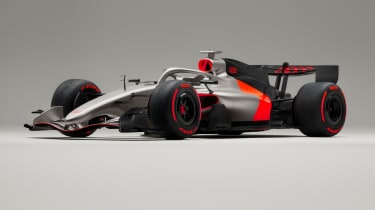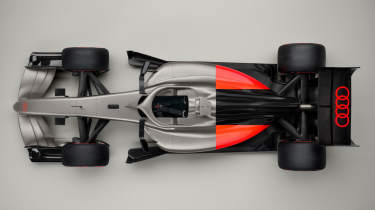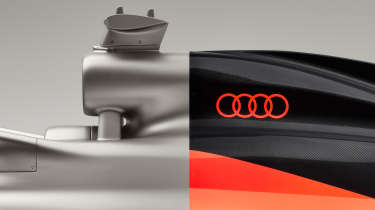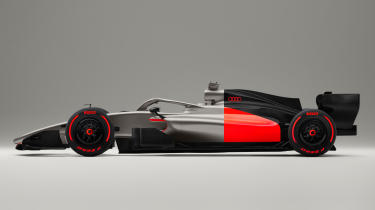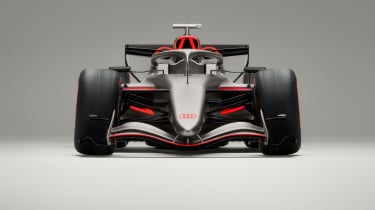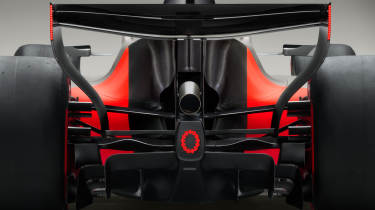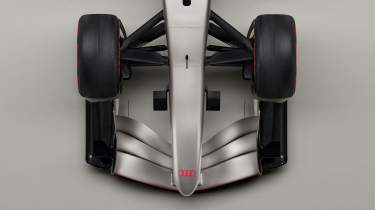Audi’s first Formula 1 design officially revealed
Audi has revealed the livery for its 2026 Formula 1 contender which is set to make its public debut in January next year
The 2026 Audi F1 team has revealed its livery and branding at an event in Munich, centred around a display car named the Audi R26 Concept. It marks the official debut of the German marque’s Formula 1 design, featuring new colours expected to be offered on future road cars.
The R26 concept is just that – it’s not the final Audi F1 car, which will have different aerodynamic surfaces and dimensions. But it is a big step for Audi’s nascent Grand Prix team, which becomes an official entity on 1 January 2026. This is a symbolic first step for the team, and gives us a chance to see its colour scheme and design identity for the first time.
> Audi Quattro (1980 - 1991) review: a 1980s road-going rally icon
Speaking at the concept’s unveiling, Audi CEO Gernot Dölner hinted that the F1 team will be part of a more sporting and high-tech direction for the company’s road cars. ‘Our entry in F1 is the start of something bigger,’ he told guests, referencing the Concept C sports car concept also on display at the event. ‘We will focus our products, our processes and our structures on what truly matters – our goal to reclaim technological leadership by becoming faster, leaner and more efficient.
‘This Formula 1 mindset will drive a new performance culture across [the business],’ he continued. ‘It's a catalyst for change towards a leaner, faster and more innovative Audi.’
The finalised car, currently in development, will make its public debut at the official team launch in January 2026. It will take its first on-track steps at the initial F1 pre-season test at Barcelona later the same month, driven by teammates Nico Hülkenburg and Gabriel Bortoleto.
evo was on the ground at the event following a tour of Audi’s motorsport HQ in Neuburg, where it is developing and assembling its own engines and wider powertrain for its Formula 1 programme.
Audi F1 team: the background
This is a car and team that has, officially at least, been two and half years in the making. Audi established its F1 subsidiary, Audi Formula Racing (AFR), in 2022 and announced a strategic partnership with the existing Sauber Formula 1 team, with the endgame to become the Audi factory team from 2026.
In March 2024, Audi announced its complete takeover of Sauber and its associated group. From the beginning of 2026, the metamorphosis from Sauber to Audi F1 will be complete.
One team, three bases
It is a true manufacturer team in the sense that, as well as its own car, Audi is creating its own power unit. While the cars themselves will be built and run out of Sauber’s existing Hinwil base in Switzerland, the power units and wider drivetrain, including the internal combustion V6 engines and hybrid powertrain elements, are assembled at Audi’s own motorsport facility at Neuburg, Germany. The first ‘fire-up’ milestone is planned to be completed soon.
Neuburg has been the base of many highly successful Audi motorsport programs, including its Le Mans, DTM and Dakar projects. F1 is a new, highly specialised field for it to adapt to. A new 3000 square metre building has been rapidly constructed, to house the new test facilities and laboratories.
Audi is familiar with the Hinwil campus, having used its wind tunnel in its Le Mans and DTM programmes.
A small technical outpost has also been set up in the UK at the Bicester Heritage site, next door to the headquarters of the British governing body Motorsport UK. It may play a crucial role in the team recruiting UK-based engineering talent who are unable to commute to the continent as an interim step, as the team grows from small, independent Sauber to big, works Audi.
High-profile recruits
Two experienced heads with prior careers in front-running F1 teams manage the new Audi squad. Heading Audi’s Formula 1 operation is former Ferrari team principal, Mattia Binotto and team principal Jonathan Wheatley, formerly sporting director at Red Bull Racing. Wheatley is a more recent recruit, having come on board in April 2025. Both report directly to Audi AG CEO Gernot Dölner.
The team has also been recruiting personnel in all departments from rival teams, to bolster Sauber’s existing workforce – including more than 150 new starters in 2025 alone.
Sauber’s 2025 driver line-up remains unchanged for the new Audi team, pairing experienced German Hülkenburg with Brazilian rookie Bortoleto, who has been rapidly gaining experience (and scoring points) in his first F1 season.
Audi’s expectations
Dölner says Audi’s goal is to fight for the championship by 2030. ‘We start as challengers but we have the right team in place and an ambitious yet realistic programme to fight for the championship by [that year].’
Binotto says Audi has a ‘three-phase’ approach: first, ‘Challenger,’ where it gains experience and grows the team’s resources and headcount. That will be followed by a ‘Competitor’ phase as it gains performance parity with front-running teams and finally – ambitiously – a Champions phase.
The existing Sauber team, already headed by Binotto and Wheatley, has already improved in pace, achieving a podium finish at the 2025 British Grand Prix.
Audi gives the impression it is thinking long-term; Binotto says that as well as working to attract established talent from other teams, it is looking at investing in engineering academies with universities to attract new talent to grow with the team.
2026: a key season for Formula 1
A key part of Audi’s strategy to launch the team for the 2026 season is because it coincides with new technical regulations, and the introduction of new cost cap measures.
Audi believes its experience with hybrid motorsport powertrains since 2012 in endurance racing, Dakar and Formula E will help it exploit the greater freedom the new regs allow in high-voltage batteries and motor-generator units. The e-motor output will triple compared with 2025’s cars and electric power forms a much greater percentage of the cars’ total output. Furthermore, the current regulations specify conversion of exhaust gas heat into energy, a complex process which is not considered relevant to road car development by Audi – and that is being dropped for 2026.
The new regulations also allow a freer choice of fuels, which must be of a formula deemed sustainable – whether synthetic or biological. Audi is partnering with BP, who will be one of the team’s sponsors, to develop its fuel. Work began in 2022.
Audi describes the project as a ‘long-term commitment’ and its goals as ‘realistic’ – its stated aim is to challenge for championship titles from 2030.
Audi CEO Gernot Döllner has stated: ‘We are not entering Formula 1 just to be there. We want to win. At the same time, we know that you don’t become a top team in Formula 1 overnight. It takes time. By 2030, we want to fight for the World Championship title.’
Binotto describes the changes as ‘one of the biggest in 30 years.’ ‘It’s about the chassis, about the power units, it’s like starting from scratch,’ he says. ‘That certainly is an opportunity but on the other side I’m very conscious that we are fighting against strong competitors who are winning today because they are well organised. We know that becoming a successful team may take several seasons.’
Why has Audi entered F1?
Formula 1 has greater reach and popularity than ever before. As many as 1.6bn people are calculated to have watched races on TV in 2024 and more races than ever are selling out of tickets. Greater exposure on social media, and other platforms – including a certain streaming docu-series – have helped the sport reach younger target groups (one in three TV viewers is now younger than 35, and more than 44 per cent of those watching races online, according to figures Audi quotes) and a larger proportion of female fans (as many as 120m new viewers worldwide). Audi considers North America, Europe and China to be key markets for its road cars – all of which have seen an increase in F1 viewing and engagement.
From a financial standpoint, budget caps now exist for both the team itself and for drivetrain development, making it easier for Audi to plan and manage the team finances over a defined period. And let’s not forget that F1 teams and their associated entries have value in themselves; Mercedes’ F1 team was recently estimated to be worth more than €4bn. Whilst Audi owns the majority of the team, the Qatari Investment Authority holds a 30 per cent stake.
‘When we look at the development of sponsorship opportunities, team evaluations, and the overall revenue potential in Formula 1, one thing becomes clear: this path makes perfect sense for Audi – also economically,’ says Jürgen Rittersberger, Audi’s chief financial officer.
The increased hybrid engineering element and sustainable fuels for 2026 also lend some environmental credentials from a marketing point of view. F1’s new sustainable fuels are required by regulation to be able to be used in production vehicles without modification, which Audi believes may have some relevance to its future road car development.
Audi R26 Concept: the design
Audi says the concept ‘provides a very distinct preview of the colour scheme and design of the brand’s first Formula 1 race car which will be unveiled in January 2026.’
The sharp colour breaks and geometric graphics use three colours, one being a metallic-looking titanium finish, and the others carbon black and a new Audi Red. The titanium colour is the same as that of the recently revealed Audi Concept C. Audi says it will feature strongly in its future colour palette. The red was designed for the F1 team, and will help pick out the brand’s rings logo from a distance.
Head of design Massimo Frascella says Audi is embarking on a new design philosophy, of which the Concept C is the first manifestation. The F1 car’s design is intended to be part of Audi’s new ‘unified design system.’ ‘We are becoming more precise in our use of colours,’ he says. ‘We introduced Titanium with the Concept C and now we are introducing a new Audi Red. It will run through the veins of our brand. We want to have the most striking car on the grid.’
While there are no sponsor logos on the concept car, expect the finished racer to include graphics from main sponsors Revolut, BP and Adidas.
